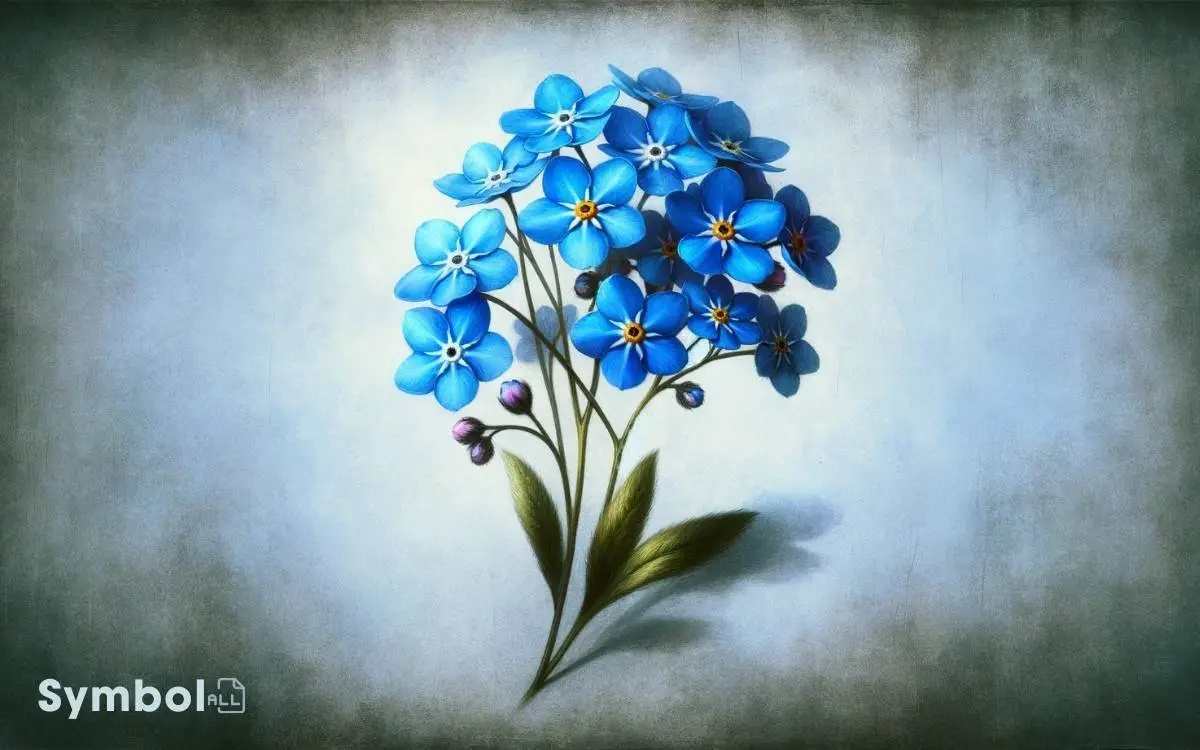Forget Me Not Flower Symbolism: Love, Strength!
You’ll find the Forget Me Not flower deeply rooted in symbolism, representing fidelity, enduring love, and the strength of emotional bonds.
Tracing back to medieval times, it symbolizes a steadfast remembrance, acting as a botanical proof of resilient relationships that transcend time and space.
Its vibrant blue petals and contrasting yellow center convey unspoken, profound emotional truths, embodying the complexity of human connections.
Scientifically, its symbolism engages cognitive psychology, demonstrating how memories anchor our present emotions to past experiences.
Exploring this flower’s symbolism reveals layers of human emotion, cultural significance, and timeless values intrinsic to human nature.

Key Takeaways
Historical Roots and Legends
Delving into the historical roots and legends of the Forget Me Not flower, it’s clear that its symbolism is deeply entrenched in various cultures and epochs, reflecting a rich tapestry of meanings and beliefs.
This delicate bloom, scientifically termed Myosotis, has been a subject of fascination across the globe, from Europe to Asia, for centuries.
Historical texts and folklore trace its significance back to medieval times, often associated with fidelity and enduring faithfulness outside the world of romantic love.
Analyzing botanical manuscripts, one discovers that herbalists and naturalists of the past attributed to the Forget Me Not both medicinal properties and symbolic values, such as the power to protect against evils and misfortunes.
This multifaceted symbol has woven itself into cultural fabrics, representing a complex interplay of human emotions and societal values.
Love and Remembrance
You’ll find that the Forget Me Not‘s symbolism extends deeply into the areas of love and remembrance, acting as a botanical proof to eternal bonds.
Its representations highlight memory’s fragile hold, emphasizing the importance of physical reminders in strengthening emotional connections.
The flower’s inherent message of affection beyond words underscores its role in non-verbal communication of deep emotional truths.
Eternal Bonds Strengthened
Throughout history, the forget-me-not flower has symbolized eternal bonds, embodying the themes of love and remembrance with remarkable precision.
This delicate flora, with its vibrant blue petals and yellow center, serves as a botanical emblem for relationships that transcend time and space.
Scientifically, Myosotis sylvatica’s memorable hue and resilience in various climates contribute to its symbolism.
These characteristics mirror the human desire for connections that endure beyond the temporal, suggesting an innate biological appreciation for constancy and reliability in social bonds.
Additionally, the flower’s widespread distribution and adaptability underscore the universality of these themes across cultures. The forget-me-not’s enduring appeal highlights our collective longing for enduring relationships, cemented in memory and strengthened by time.
Memorys Fragile Hold
In exploring the symbolism of the forget-me-not flower, it’s important to acknowledge how it encapsulates the complex nature of memory and its pivotal role in love and remembrance.
- Neurobiology of Memory: Scientific studies reveal that emotional experiences, such as those shared in love, are more likely to be remembered. The forget-me-not symbolizes this by representing memories that persist despite the fragility of our neural connections.
- Symbolic Representation: The flower serves as a tangible reminder of memories that might fade with time, acting as a catalyst for recall and strengthening neural pathways associated with those memories.
- Cognitive Psychology: Research in cognitive psychology suggests that symbols like the forget-me-not can trigger episodic memory retrieval, thereby reinforcing connections between present emotions and past experiences.
Affection Beyond Words
The forget-me-not’s symbolism extends deeply into the worlds of love and remembrance, embodying the profound, often inexpressible feelings of affection that persist beyond the limitations of verbal communication.
| Aspect | Scientific Insight | Symbolic Meaning |
|---|---|---|
| Color | The blue hue reflects stability and depth in emotions | Eternal love |
| Growth Pattern | Thrives in harsh conditions, symbolizing resilience | Strength of memory |
| Seasonal Blooming | Spring emergence signifies renewal | Rebirth of love |
| Distribution | Widespread across temperate zones | Universal nature of love |
This concise examination reveals the forget-me-not as more than a mere floral emblem; it’s a manifestation of the enduring nature of love and the persistence of memory, silently communicating affection and reminiscence through its very existence.
Spiritual and Religious Meanings
You’ll find that the Forget Me Not carries profound spiritual and religious symbolism, particularly in its embodiment of eternal love and its role in remembrance during ceremonies.
Scientific analysis reveals that this flower’s unique morphology and coloration have made it a symbol of fidelity and everlasting affection across various cultures.
In addition, its frequent inclusion in religious ceremonies underscores its significance in evoking memory and spiritual connection.
Eternal Love Representation
Forget-me-not flowers embody the concept of eternal love through their enduring presence in spiritual and religious traditions across cultures. These delicate blooms serve as symbols of an unbreakable bond that transcends time and physical space.
Understanding their significance requires an analytical approach to their spiritual and religious connotations.
- Biological Perseverance: Scientifically, these flowers thrive in adversity, mirroring the resilience of everlasting love.
- Historical Context: Throughout history, various cultures have incorporated forget-me-nots in spiritual rituals, emphasizing their role in representing eternal bonds.
- Symbolic Interpretation: In religious texts, these flowers often symbolize the constancy and fidelity inherent to spiritual love, suggesting a divine or transcendent quality to such connections.
Remembrance in Ceremonies
In many cultures, forget-me-nots serve as pivotal elements in ceremonies commemorating the deceased, symbolizing the enduring nature of memory and the spiritual connections that transcend physical loss.
These flowers embody a nexus between the living and those who’ve passed, encapsulating the essence of remembrance within their delicate blooms.
| Culture | Significance |
|---|---|
| Western | Often used in funerals and memorial services to signify lasting memory and respect for the deceased. |
| Eastern | Incorporated in ceremonies as a symbol of the soul’s immortality and the continuation of life beyond death. |
| Indigenous | May represent the spiritual journey and the cycle of life and death, highlighting the ancestors’ ongoing presence in the community. |
| Contemporary | Utilized in various spiritual practices to honor the memory of loved ones, fostering a sense of connection and continuity.
Cultural Significance Worldwide
Across various cultures, the forget-me-not flower holds deep symbolic significance, often embodying themes of remembrance, love, and respect. Delving into its cultural significance reveals a multifaceted symbol that transcends geographical boundaries.
To understand its worldwide impact, consider the following:
- Germany: Here, the flower is often associated with romantic love and tragic legend, symbolizing enduring memories between separated lovers.
- Armenia: It serves as a symbol of commemoration for the Armenian Genocide, representing collective memory and the undying hope for recognition and justice.
- United Kingdom: In British folklore, it’s believed to symbolize true love and respect, with tales suggesting knights wore them as a sign of faithfulness and to make sure they wouldn’t be forgotten by their maidens.
These examples underscore the forget-me-not’s role as a universal symbol of persistent memory, emotional depth, and cultural reverence, demonstrating its profound significance across diverse societies.
In Literature and Art
Literature and art have long embraced the forget-me-not flower, weaving its symbolism into narratives and visuals that explore themes of memory, love, and the human condition.
You’ll find that authors and artists meticulously incorporate this delicate bloom to signify enduring love and the persistence of memory amidst the transience of life.
In detailed analysis, the forget-me-not’s presence often foreshadows moments of poignant remembrance or acts as a talisman against oblivion. Through careful examination, its recurring motif in paintings underscores a connection to themes of fidelity and remembrance.
Scientific scrutiny reveals how its distinctive blue hue and unassuming appearance contrast with its profound symbolic weight, offering a rich vein of interpretation for those who seek to understand its enduring appeal in the arenas of literature and art.
Garden and Horticultural Use
Beyond its symbolic significance, the forget-me-not flower thrives in garden settings due to its adaptability and low maintenance requirements, offering a blend of aesthetic appeal and practical utility.
When integrating these flowers into your garden, consider the following:
- Soil and Light Conditions: Forget-me-nots prefer moist, well-drained soil and thrive in both full sun and partial shade. This versatility allows them to be planted in various locations.
- Propagation Techniques: These flowers can be easily propagated by seed, spreading to cover ground effectively. This natural proliferation guarantees a continuous display of blooms without extensive manual intervention.
- Pest and Disease Management: They exhibit remarkable resistance to common garden pests and diseases, minimizing the need for chemical interventions and supporting a more organic gardening approach.
Contemporary Symbolism and Use
In today’s digital age, forget-me-nots have evolved to symbolize memory and connection, reflecting their enduring presence in both virtual and real-life commemorations.
You’ll find these flowers embedded in social media tributes and digital memorials, where their image serves as a poignant reminder of individuals and moments that shouldn’t be forgotten.
Scientifically, this shift from physical to digital representation hasn’t altered their symbolic value; rather, it has amplified it. The forget-me-not’s ability to thrive in various climates mirrors its adaptability in the face of changing modes of remembrance.
Its delicate yet resilient nature underscores the message that memories, like these flowers, persist despite the passage of time or the shift from tangible gardens to digital platforms.
Conclusion
The Forget-Me-Not flower‘s fascinating fusion of historical heritage and horticultural beauty bridges bonds between love’s lasting memory and spiritual significance.
Its vivid variations serve as symbolic sentinels across cultures, commemorating connections and kindling remembrance.
Scientific scrutiny shows its significance spans from genetic gifts to global gardens, making it a multifaceted marvel in both ecological and emotional domains.
This botanical emblem encapsulates an enduring essence, eloquently echoing eternally in every petal and leaf.






